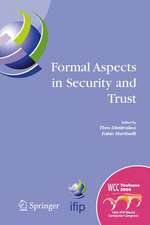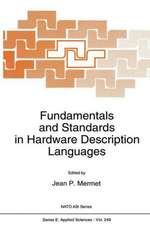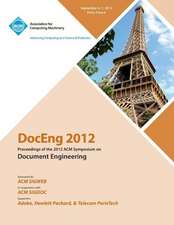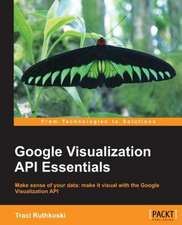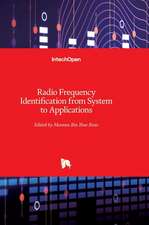Programming Media Art Using Processing: A Beginner's Guide
Autor Margaret Nobleen Limba Engleză Paperback – 17 dec 2020
This book provides a linear series of lessons with step-by-step examples that lead to beginning media art projects, including abstract designs, pixel landscapes, rollover animations, and simple video games. Computer programming can be overwhelming for the first-time learner, but this book makes the learning of code more digestible and fun through a full color, well-diagrammed, and deeply explained text presentation. Lessons are rhythmically broken down into digestible parts with code annotations and illustrations that help learners focus on the details one step at a time. The content is legible, flexible, and fun to work with because of its project-based nature.
By following the lessons and producing the projects sequentially in this book, readers will develop the beginning foundational skills needed to understand computer programming basics across many languages and also explore the art of graphic design. Ultimately, this is a hands-on, practical guide.
To learn more about Margaret Noble's work, please visit her artist's website and educator website.
Toate formatele și edițiile
| Toate formatele și edițiile | Preț | Express |
|---|---|---|
| Paperback (1) | 330.94 lei 6-8 săpt. | |
| CRC Press – 17 dec 2020 | 330.94 lei 6-8 săpt. | |
| Hardback (1) | 951.33 lei 6-8 săpt. | |
| CRC Press – 17 dec 2020 | 951.33 lei 6-8 săpt. |
Preț: 330.94 lei
Preț vechi: 363.70 lei
-9% Nou
Puncte Express: 496
Preț estimativ în valută:
63.32€ • 66.12$ • 52.41£
63.32€ • 66.12$ • 52.41£
Carte tipărită la comandă
Livrare economică 04-18 aprilie
Preluare comenzi: 021 569.72.76
Specificații
ISBN-13: 9780367508289
ISBN-10: 0367508281
Pagini: 248
Ilustrații: 31 Tables, black and white; 278 Illustrations, color
Dimensiuni: 152 x 229 x 16 mm
Greutate: 0.41 kg
Ediția:1
Editura: CRC Press
Colecția Chapman and Hall/CRC
ISBN-10: 0367508281
Pagini: 248
Ilustrații: 31 Tables, black and white; 278 Illustrations, color
Dimensiuni: 152 x 229 x 16 mm
Greutate: 0.41 kg
Ediția:1
Editura: CRC Press
Colecția Chapman and Hall/CRC
Public țintă
Academic and Professional Practice & DevelopmentCuprins
Acknowledgements and Contributor List
Author Bio
Introduction and Best Practices
Chapter 1: Designing Graphically with the Language of Code
Getting Started & Basic Overview
Lesson 1.1: Pixel Grid System
Lesson 1.2: Code and Canvas Windows
Lesson 1.3: More Shapes
Lesson 1.4: Grayscale
Lesson 1.5: Syntax, Comments, and Order of Code
Lesson 1.6: Line Commands (Stroke and No Stroke)
Lesson 1.7: Coloring Pixels
Lesson 1.8: Adding Transparency Values
Lesson 1.9: The Processing Reference – Important Resource!
Project: Geometric Design
Chapter 2: Creating Responsive Environments
Lesson 2.1: Dynamic Computer Programs
Lesson 2.2: First Animations
Lesson 2.3: Animation Trails
Lesson 2.4: Finding Exact Coordinates
Lesson 2.5: Complex Shapes
Lesson 2.6: Linking Shapes for Synched Movement
Lesson 2.7: Adding Text
Lesson 2.8: Rotating Shapes
Project: Interactive Environment
Chapter 3: Automated Animations
Lesson 3.1: Counting Variables
Lesson 3.2: Moving Objects in Multiple Directions
Lesson 3.3: Growing Shapes with the Mouse
Lesson 3.4: Println() for Debugging
Lesson 3.5: Constrain() for Stopping Animations
Lesson 3.6: Random() Opportunities
Lesson 3.7: Automated Rotations
Project: Automated Environment
Chapter 4: Animated Collages
Lesson 4.1: Preparing and Importing Imagery
Lesson 4.2: Moving Images
Lesson 4.3: Fading and Coloring Images using Tint()
Lesson 4.4: Resizing Images & Multiples
Lesson 4.5: Constraining Mouse Movements
Lesson 4.6: Void Key Pressed() and Image Rotations
Lesson 4.7: Create Fonts
Lesson 4.8: Project Optimization and noSmooth()
Project: Animated and Interactive Collage
Chapter 5: Conditional Interactions and Rollovers
Lesson 5.1: Conditional Statements and Relational Operators
Lesson 5.2: Conditional Statements with Custom Variables
Lesson 5.3: And vs. Or
Lesson 5.4: Logical Operators Defining Spaces
Lesson 5.5: Variations with Mouse and Keyboard Actions
Lesson 5.6: Two Variables: Alternating Movements
Lesson 5.7: Color Detection Using the Get() Function
Project: Rollover Animation
Chapter 6: Events and Interactions for Simple Games: Part 1
Lesson 6.1: Turning Things on with Boolean Variables
Lesson 6.2: Toggling Between Two States Using Boolean Variables
Lesson 6.3: Multiple Buttons Alternating
Lesson 6.4: Booleans Working with Counting Variables
Lesson 6.5: Specific Keyboard Interactions
Lesson 6.6: Creating a Walking Character
Lesson 6.7: Boundaries
Chapter 7: Events and Interactions for Simple Games: Part 2
Lesson 7.1: Timers
Lesson 7.2: Continuous Motion Key Controls
Lesson 7.3: For Loops are Efficient
Lesson 7.4: Color Detection with For Loops
Lesson 7.5: Game Creation from Keys, Loops, and Color Detection
Lesson 7.6: Image Collisions with the Distance() Function
Lesson 7.7: Two Players, Directional Movement, and Jumping!
Chapter 8: Multilevel Architectures and Arrays
Lesson 8.1: Basic Levels Architecture
Lesson 8.2: States within Levels
Lesson 8.3: Arrays
Lesson 8.4: Image Arrays
Lesson 8.5: Player Options
Lesson 8.6: Choice Based Projects
Conclusion
Final Project: Multilevel Interactive Experience
Author Bio
Introduction and Best Practices
Chapter 1: Designing Graphically with the Language of Code
Getting Started & Basic Overview
Lesson 1.1: Pixel Grid System
Lesson 1.2: Code and Canvas Windows
Lesson 1.3: More Shapes
Lesson 1.4: Grayscale
Lesson 1.5: Syntax, Comments, and Order of Code
Lesson 1.6: Line Commands (Stroke and No Stroke)
Lesson 1.7: Coloring Pixels
Lesson 1.8: Adding Transparency Values
Lesson 1.9: The Processing Reference – Important Resource!
Project: Geometric Design
Chapter 2: Creating Responsive Environments
Lesson 2.1: Dynamic Computer Programs
Lesson 2.2: First Animations
Lesson 2.3: Animation Trails
Lesson 2.4: Finding Exact Coordinates
Lesson 2.5: Complex Shapes
Lesson 2.6: Linking Shapes for Synched Movement
Lesson 2.7: Adding Text
Lesson 2.8: Rotating Shapes
Project: Interactive Environment
Chapter 3: Automated Animations
Lesson 3.1: Counting Variables
Lesson 3.2: Moving Objects in Multiple Directions
Lesson 3.3: Growing Shapes with the Mouse
Lesson 3.4: Println() for Debugging
Lesson 3.5: Constrain() for Stopping Animations
Lesson 3.6: Random() Opportunities
Lesson 3.7: Automated Rotations
Project: Automated Environment
Chapter 4: Animated Collages
Lesson 4.1: Preparing and Importing Imagery
Lesson 4.2: Moving Images
Lesson 4.3: Fading and Coloring Images using Tint()
Lesson 4.4: Resizing Images & Multiples
Lesson 4.5: Constraining Mouse Movements
Lesson 4.6: Void Key Pressed() and Image Rotations
Lesson 4.7: Create Fonts
Lesson 4.8: Project Optimization and noSmooth()
Project: Animated and Interactive Collage
Chapter 5: Conditional Interactions and Rollovers
Lesson 5.1: Conditional Statements and Relational Operators
Lesson 5.2: Conditional Statements with Custom Variables
Lesson 5.3: And vs. Or
Lesson 5.4: Logical Operators Defining Spaces
Lesson 5.5: Variations with Mouse and Keyboard Actions
Lesson 5.6: Two Variables: Alternating Movements
Lesson 5.7: Color Detection Using the Get() Function
Project: Rollover Animation
Chapter 6: Events and Interactions for Simple Games: Part 1
Lesson 6.1: Turning Things on with Boolean Variables
Lesson 6.2: Toggling Between Two States Using Boolean Variables
Lesson 6.3: Multiple Buttons Alternating
Lesson 6.4: Booleans Working with Counting Variables
Lesson 6.5: Specific Keyboard Interactions
Lesson 6.6: Creating a Walking Character
Lesson 6.7: Boundaries
Chapter 7: Events and Interactions for Simple Games: Part 2
Lesson 7.1: Timers
Lesson 7.2: Continuous Motion Key Controls
Lesson 7.3: For Loops are Efficient
Lesson 7.4: Color Detection with For Loops
Lesson 7.5: Game Creation from Keys, Loops, and Color Detection
Lesson 7.6: Image Collisions with the Distance() Function
Lesson 7.7: Two Players, Directional Movement, and Jumping!
Chapter 8: Multilevel Architectures and Arrays
Lesson 8.1: Basic Levels Architecture
Lesson 8.2: States within Levels
Lesson 8.3: Arrays
Lesson 8.4: Image Arrays
Lesson 8.5: Player Options
Lesson 8.6: Choice Based Projects
Conclusion
Final Project: Multilevel Interactive Experience
Notă biografică
Margaret Noble was born in Texas, raised in San Diego, and received her key artistic training in Chicago. She holds a B.A. in Philosophy from the University of California, San Diego and an MFA in Studio and Sound Art from the School of the Art Institute of Chicago. Margaret Noble is an accomplished media producer with a background in public education, artistic production, and large-scale exhibition development. Her artworks have been exhibited nationally and internationally. Margaret Noble came to education from industry as a professional artist. Throughout her 13+ years of teaching in secondary and higher education, she has consistently supported diverse learners in producing meaningful, community driven, multimedia projects. Margaret and her students have also received several awards and recognitions for their classroom projects including features in Edutopia and Wired magazine. To learn more about Margaret Noble’s work, please visit: https://www.margaretnoble.com/
Descriere
Programming Beginning Media Art for Non-Programmers provides an entry level exploration into visual design through computer programming using the open source and artist friendly language, Processing. Used by hundreds of students - this learning system breaks lessons down into strategic steps towards fun and creative media art projects.


